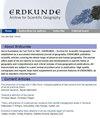Spatial differentiation of China’s industrial enterprise R&D efficiency
IF 1.1
4区 社会学
Q3 GEOGRAPHY
引用次数: 3
Abstract
Technology innovation is a key factor of international competitiveness and promotion of economic growth. As a core driver of technological innovation, research and development (R&D) activity has a direct impact on a nation’s level of innovation. Therefore, many countries attempt to strengthen innovation outcomes by increasing expenditure on R&D. However, there is not a simple linear relation between R&D activity and outcomes, and many authors take R&D efficiency as the key indicator of a company or region’s capability to innovate. China’s spending on R&D has accelerated in recent years, reaching 1.97 trillion yuan (about $286 billion) in 2018, ranking second in the world. This paper focus on discussing the R&D efficiency of China’s industrial enterprises. R&D efficiency refers to the conversion efficiency between input and output of all factors in the R&D process, reflecting the contribution of R&D input to R&D output or the allocation efficiency of R&D resources. Due to different levels of regional development, there are also different levels of R&D performance across these regions. The R&D capabilities of enterprises show significant variation across regions. Lee and Park (2005) classifies 27 countries into four clusters based on their output-specialized R&D efficiency: inventors, merchandisers, academicians and duds, showing for example that Singapore ranks high in total efficiency while Japan demonstrates patent-oriented efficiency. Meanwhile, mainland China, South Korea, and Chinese Taiwan are found to be relatively inefficient in R&D. SPATIAL DIFFERENTIATION OF CHINA’S INDUSTRIAL ENTERPRISE R&D EFFICIENCY中国工业企业研发效率的空间分化
技术创新是提高国际竞争力和促进经济增长的关键因素。研究与开发(R&D)活动作为技术创新的核心驱动力,直接影响一个国家的创新水平。因此,许多国家试图通过增加研发支出来加强创新成果。然而,研发活动与成果之间并不存在简单的线性关系,许多学者将研发效率作为衡量企业或地区创新能力的关键指标。近年来,中国的研发支出加速增长,2018年达到1.97万亿元人民币(约合2860亿美元),位居世界第二。本文主要讨论中国工业企业的研发效率问题。研发效率是指研发过程中各要素投入与产出之间的转换效率,反映了研发投入对研发产出的贡献或研发资源的配置效率。由于区域发展水平的不同,区域间的研发绩效水平也存在差异。企业研发能力在区域间存在显著差异。Lee和Park(2005)根据产出专业化的研发效率将27个国家分为发明人、商人、院士和失败者四类,例如新加坡在总效率方面排名较高,而日本则表现出专利导向的效率。与此同时,中国大陆、韩国和中国台湾地区的研发效率相对较低。中国工业企业研发效率的空间分异
本文章由计算机程序翻译,如有差异,请以英文原文为准。
求助全文
约1分钟内获得全文
求助全文
来源期刊

Erdkunde
地学-自然地理
CiteScore
2.00
自引率
7.10%
发文量
17
审稿时长
>12 weeks
期刊介绍:
Since foundation by Carl Troll in 1947, ''ERDKUNDE – Archive for Scientific Geography'' has established as a successful international journal of geography. ERDKUNDE publishes scientific articles covering the whole range of physical and human geography. The journal offers state of the art reports on recent trends and developments in specific fields of geography and comprehensive and critical reviews of new geographical publications. All manuscripts are subject to a peer-review procedure prior to publication. High quality cartography and regular large sized supplements are prominent features of ERDKUNDE, as well as standard coloured figures.
 求助内容:
求助内容: 应助结果提醒方式:
应助结果提醒方式:


